
|
||||||||||||||||
|---|---|---|---|---|---|---|---|---|---|---|---|---|---|---|---|---|
|
Kakani Katija Young |
||||||||||||||||
|
||||||||||||||||
Current ResearchPrior ResearchScientific Outreach |
Biologically-induced mixing in the salt-stratified lakes of PalauTurbulence in the oceans is generated by mechanisms that include tides, winds and swimming animals. Turbulence is effective in mixing because it is active over a range of scales. Biologically-induced mixing is an engaging topic amidst recent controversy; it suggests that billions of small organisms swimming in the deep ocean stir water upward, thus contributing to global circulation and climate. Can mechanical energy at these small scales achieve any substantial heating before it is dissipated as heat? How can we measure the mixing efficiency of aquatic animals and isolate their contributions from other sources of mixing? Do natural systems exist where organisms partake in migration patterns that contribute to mixing absent the effects of surface winds and tides? In this project, combined with the implementation of a Self-Contained Underwater Velocimetry Apparatus (SCUVA), we will measure the mixing efficiency of swimming organisms (e.g. medusae and copepods) in the unique, salt-stratified lakes of Palau, where the effects of tidal and wind mixing are negligible. 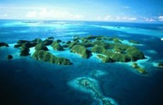
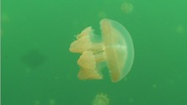
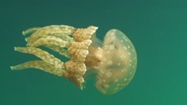
Related Publications:
Field measurements of aquatic animal-fluid interactions using a Self-Contained Underwater Velocimetry Apparatus (SCUVA)A Self-Contained Underwater Velocimetry Apparatus (SCUVA) enables a single SCUBA diver to make digital particle image velocimetry (DPIV) measurements of animal-fluid interactions in real-time. The device can be used to study the dynamics of jellyfish swimming in-situ (e.g. lakes, coastal waters, deep oceans). After the design and implementation of SCUVA, we analyze the DPIV measurements by computing the kinetic energy in the flow field induced by the animal swimming motions. These results are compared with an existing theoretical model and we find that the results are consistent with one another. Unlike the model, SCUVA provides details regarding the temporal evolution of energetics during a swimming cycle. These results demonstrate the usefulness of SCUVA as a method to obtain quantitative field measurements of in-situ animal-fluid interactions. 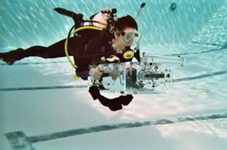
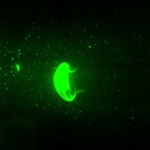
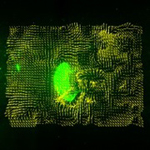
Related Publications:
A Lagrangian perspective on vortex ring pinch-offAt long vortex ring formation times, a leading vortex is "pinched-off" from the vortex generator and a trailing jet is formed. The pinch-off process is an active area of research; however, it is difficult to understand vortex ring pinch-off without a method that accurately distinguishes the leading vortex boundary from the trailing jet. Such a methodology already exists in dynamical systems theory through the identification of Lagrangian coherent structures (LCS) from the finite-time Lyapunov exponent field. In this paper, LCS is used to define the boundary between the leading vortex and trailing jet to accurately determine the formation time corresponding to pinch-off (or formation number). We propose criteria based on tangency of the LCS with (1) the minimum contour level of the trailing jet at 5% peak vorticity, (2) the minimum contour level of the trailing jet at 50% peak vorticity and (3) the exit plane of the vortex ring generator cylinder to identify pinch-off. The difference in formation number between criteria (1) and (2) is approximately 0.5 formation time steps. We find that the pinch-off criterion in which the LCS is tangent to the exit plane of the cylinder is the most robust based on its independence from vorticity contours. 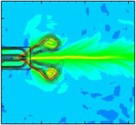
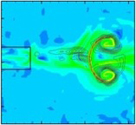
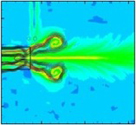
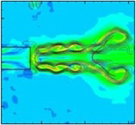
Dynamics of tethered vs. free-swimming animalsPrevious research has shown that jellyfish utilize the formation and shedding of vortices to help feed and move the animal. Laboratory experiments often require restricting the motion of an animal by tethering/fluming to allow for repeatable results. However, past research has not addressed the differences that arise when the motion of an animal is restricted/confined. This project compares the wake structure of a tethered and free-swimming Aurelia labiata. DPIV is used to collect measurements of the velocity field surrounding an animal that is either tethered or swimming freely. Dynamical systems methods are used to compute Lagrangian coherent structures (LCS), which identifies the geometries of structures in the wake of the animal. Using LCS, a comparison between the wake of a tethered and free-swimming animal can be made. This research provides a quantitative measure of the differences between a tethered and freely moving jellyfish. 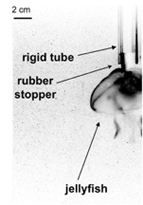 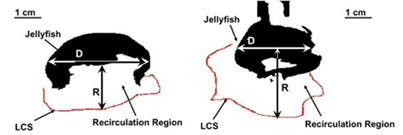
|
|||||||||||||||
|
||||||||||||||||
|
last modified: September 20, 2011 |
||||||||||||||||